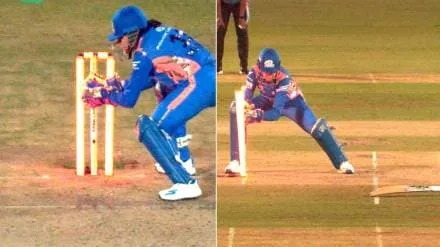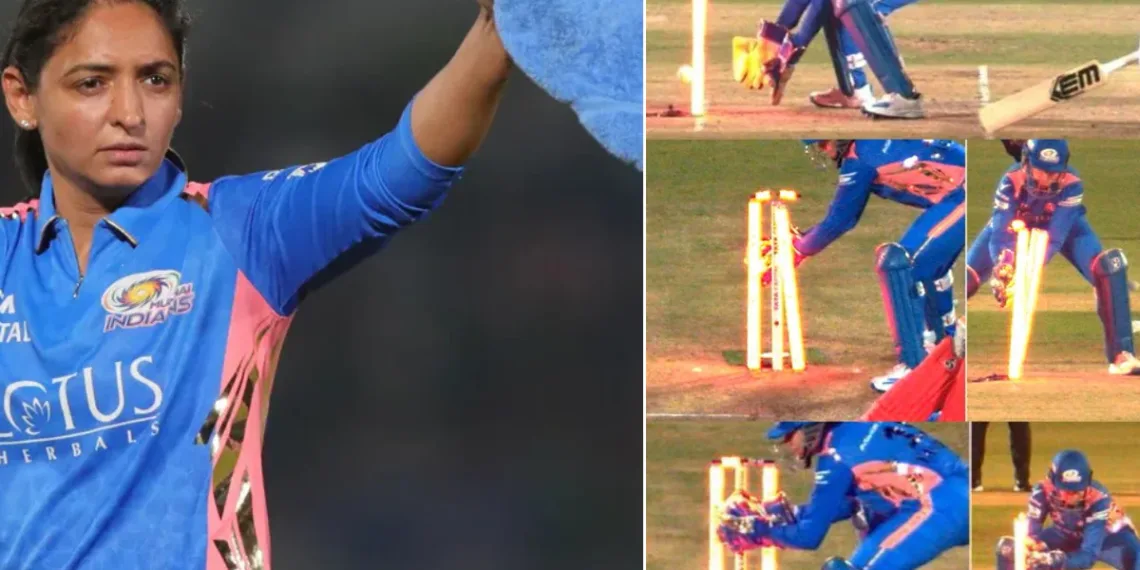Picture this: It’s the final over of a nail-biting Women’s Premier League (WPL) match. The batter dives for the crease, the keeper whips off the bails, and suddenly… confusion reigns. Welcome to the world of cricket in 2025, where even the bails have gone high-tech, and sometimes, they’re the ones causing all the drama.
The bail controversy in WPL 2025 has sparked intense debate among cricket fans and experts alike. It’s a tale of technology, tradition, and a tiny piece of cricket equipment that usually doesn’t get much attention. But on February 15, 2025, those little LED-lit bails became the talk of the town. Let’s dive into what happened, why it matters, and how it’s changing the game we love.
Table of Contents
At least 4 run-out calls took place today in the WPL MI vs DC game which were crazily close.
— Aakash (@AakashCric) February 15, 2025
The third umpire decided to consider the moment when both bails fell off, rather than the bails lighting up.
Which is a more correct approach 🤔 pic.twitter.com/StTtMrozsn
The Match That Sparked the Controversy
It was Delhi Capitals vs Mumbai Indians, a clash of titans in the WPL 2025. The match was a thriller, with DC clinching a two-wicket victory. But it wasn’t the result that made headlines; it was three contentious run-out decisions that set the cricketing world abuzz.
The DC vs MI controversy highlighted the need for clearer guidelines in cricket’s use of technology. Here’s what went down:
- In the 18th over, Shikha Pandey of DC was involved in a close run-out call. The ball deflected off the keeper, hit the stumps, and the bails lit up. But was she out?
- Later, Radha Yadav found herself in a similar situation. The bails flashed their lights, but was her bat in the crease when it mattered?
These moments left players, umpires, and fans scratching their heads. The rules said one thing, but the technology seemed to be saying another. It was clear that something had to give.
The LED Bail Glitch: Understanding the Root of the Controversy
The LED bail glitch during the crucial match led to confusion and ultimately, a significant rule change. But what exactly are these high-tech bails, and why are they causing such a stir?
Zing bails, designed to enhance visibility, became the unexpected center of attention in this high-stakes game. These aren’t your grandfather’s wooden bails. Zing bails are equipped with LED lights that flash when they’re dislodged from the stumps. They’re meant to help umpires make quick, accurate decisions, especially in low-light conditions or for close stumping calls.
But here’s the catch: in the WPL 2025 match, these bails were lighting up at the slightest touch, even when they weren’t fully dislodged. It’s like having a car alarm that goes off when a leaf falls on it – not exactly helpful.
BCCI’s Swift Action: The WPL 2025 Rule Change Explained
In response to the chaos, the Board of Control for Cricket in India (BCCI) didn’t waste time. The WPL 2025 rule change aims to clarify when a wicket is considered broken, addressing the issues raised by the bail controversy.
Here’s what you need to know about the new rule:
- The LED bails must be completely dislodged from the grooves of the stumps for a wicket to be considered broken.
- Just because the lights flash doesn’t mean it’s out. The bails need to come off entirely.
- This applies to both run-outs and stumpings.
It’s a return to basics in a way, aligning more closely with traditional cricket laws. But it also raises questions about the role of technology in the sport.
Player Reactions and Expert Opinions
As you’d expect, players and pundits had plenty to say about this turn of events.
Renuka Singh, the Purple Cap holder, emphasized the need for clear guidelines: “In the heat of the moment, we need to know exactly what counts. These bails were confusing everyone.”
Mumbai Indians captain Harmanpreet Kaur was seen approaching the umpires during the match, seeking clarification. It’s not every day you see a captain needing a rulebook in the middle of a game!
Cricket experts Lisa Sthalekar and Mike Hesson expressed their confusion over the rulings. “We need consistency,” Sthalekar said. “If we’re using technology, it needs to be reliable and clear-cut.”

The Bigger Picture: Technology in Cricket
The bail concept in cricket has evolved with technology, but this incident shows there’s still room for improvement. It’s not just about making the game more exciting for viewers; it’s about ensuring fair play and clear decision-making.
Some experts oppose bail technology’s current implementation, arguing it can lead to unfair decisions. It’s a classic case of innovation outpacing regulation, and cricket is now playing catch-up.
But let’s not throw the baby out with the bathwater. Technology has brought many positives to cricket – from DRS to ball-tracking. The challenge is finding the right balance between tradition and innovation.
What This Means for Future Matches
So, what can cricket fans expect going forward? Here are a few predictions:
- Umpires will likely be extra vigilant about checking if bails are fully dislodged.
- We might see further tweaks to the Zing bail technology to make it more accurate.
- Players and coaches will be drilling these new rules into their match strategies.
- Expect more debates about the role of technology in cricket – this controversy has opened a can of worms!
The Evolution of Cricket Rules: A Never-Ending Innings
Cricket has always been a game of traditions, but it’s also one that’s constantly evolving. From the introduction of T20s to the use of DRS, the sport has shown it can adapt and grow.
The bail controversy of WPL 2025 is just another chapter in this ongoing story. It’s a reminder that even the smallest parts of the game can have a big impact. As fans, players, and officials, we’re all part of this evolution.
So, the next time you watch a cricket match and see those LED bails light up, remember the drama of WPL 2025. It’s not just about the flashing lights – it’s about the constant balance between tradition and innovation that keeps our beloved sport moving forward.
Who knows what the next technological advancement in cricket will be? One thing’s for sure – it’ll keep us talking, debating, and loving this game for years to come. Howzat for progress?
Read more: IPL 2025 Tickets: Your Complete Guide From Prices to Pitch-Side Seats
FAQ
What exactly is the ‘bail controversy’ in WPL 2025?
It refers to multiple run-out and stumping decisions where the LED bails lit up prematurely. The confusion around whether illumination alone signified a valid out led the BCCI to update its rules, requiring the bails to be fully dislodged instead of just lighting up.
Why did the BCCI change the rules?
The BCCI noticed a recurring problem: the LED bails would sometimes flash at minimal contact. This caused contentious decisions and protests from players. To make the game fairer and more consistent with traditional cricket laws, they decided bails must now be removed entirely from the stumps to declare a wicket.
What if a bail lights up but doesn’t fall off?
Under the new rule, the batter survives. Lighting up alone no longer confirms a wicket—complete removal from the stumps is a must.








